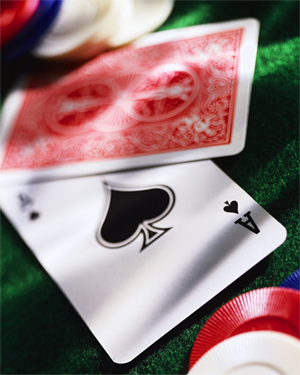As a software engineer, I tend to be very methodical in my thinking. I approach every problem by breaking it down into discrete pieces, analyzing each one in a logical fashion, and following a series of coherent steps to a solution. It’s easy for me to picture my conscious, problem-solving mind as a some sort of geared device, a Rube Goldberg machine, or even a computer applying an algorithm.
But what about creative thinking? What about moments of inspiration? You’re sitting on the can and WHAM, out of nowhere, an idea hits you. There was no conscious thought process, no gears turning, nothing visible happening. It’s as if creativity happens behind a curtain and when the process completes, your unconscious hands you an answer. What physical analogy could explain what happens behind this “curtain”?

When it comes to creativity, the analogy of gears and machines seems largely unsatisfying, failing to provide an explanation for both (a) the random and unpredictable aspects of creative thinking, such as how answers and ideas can just appear at any time or place and (b) the more deterministic trends, such as some people consistently being more creative than others and some situations fostering more creativity than others. Rather appropriately, a possible solution to this problem came to me in a moment of inspiration: seemingly out of nowhere, I started to think about coin flips, index cards and an interesting analogy came to mind.
Creative thinking as a deck of index cards
Imagine that you have a deck of index cards and that each card has a word or phrase on it. These cards represent the ideas and thoughts that are floating in your head. The creative thought process can then be seen as:
- Shuffle the index cards.
- Drop them on the floor.
- Scan over the cards and see what sentences have formed from the random arrangement of words.
Most of the time, the random permutations of words will be meaningless. You just have to pick up the cards and return to step 1. However, every now and then, a meaningful sentence or thought will emerge. Sometimes this will be a full solution to a problem - the “aha!” moment; other times, this will be a mere stepping stone from which you gather enough info to add or remove index cards from your deck before returning to step 1.
What I like about this analogy

- It cleanly explains the unpredictability of the creative thought process without resorting to any magical or divine reasoning. Sometimes the cards fall the way you want, sometimes they don’t.
- The particular choice of cards in your deck and the way you adjust them
with each iteration is a great model for why your creativity may “click” for
some problems and not for others. For example, consider “linguistic
equations” or
“DITLOIDS” style puzzles
(warning: these links are highly addictive). Most people are able to solve a
few very quickly, but get stuck on the rest for a long time. This could be
seen as the natural outcome of which index cards you pull into your deck as
you read each problem. For example, when you see the number 26, there are
very few concepts - and consequently index cards - that you would associate with that number. The size of the deck is small and it only takes a few trials before a meaningful answer emerges. On the other hand, a number like 3 has MANY possibilities, resulting in many more cards in the deck and consequently many more iterations before you stumble upon the proper permutation. - We can also explain why, even when faced with the same types of problems, you creativity may fluctuate by considering the possibility that not all the possible “index cards” of your mind are equally accessible. Depending on what you’ve been doing and thinking about, some words/phrases will be top of mind and readily pulled into your deck; other cards will represent concepts you haven’t considered in a long time, stashed in the deep recesses of your memory, and will rarely get pulled into a deck.
- I’ve always find that increased constraints lead to increased creativity. If I’m trying to solve too big or vague of a problem, I actually find it harder to come up with ideas than when faced with a smaller and more clearly defined problem. Again, the card analogy works here: broad and vague problems would be pulling in cards from all over your mind. These would represent totally unrelated thoughts and ideas and result in permutations that are completely meaningless. On the other hand, more constrained problems would result in pulling in cards that are closely related and consequently, much more likely to form coherent thoughts when they land next to each other.
- Finally, the index card system has several tuning points that could account for the creativity differences between people. This could result from varying values in the total number of cards available, the number of iterations per unit time the person can do, the ability to scan cards after each iteration and recognize that a permutation has meaning or value, the skill of picking which cards to put into the deck initially and the ability to adjust the cards in the deck after each iteration.
Vegas?

If this analogy were true, it would suggest that the brain uses a Las Vegas Algorithm for creative thinking. This may also help explain why brainstorming sessions can be an effective way to get creativity going: they are a conscious way to pull in ideas and try all sorts of permutations until, hopefully, a useful one emerges. Einstein may have refused the idea that God would play dice, but perhaps, behind the curtain of our unconscious, we are just playing cards.
Yevgeniy Brikman
If you enjoyed this post, you may also like my books, Hello, Startup and Terraform: Up & Running. If you need help with DevOps or infrastructure, reach out to me at Gruntwork.
